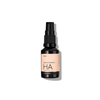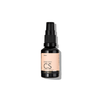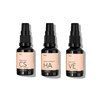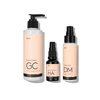Undoing Summer: Sun Damage Skin Repair - Your Winter Skincare Guide
Sun damage is a real bummer, right? It's not just about getting a lobster-red sunburn. Over time, too much sun can lead to your skin aging faster than it should, changing colour, or even increasing your risk of skin cancer. You might spot the signs as new or changing moles, freckles, rough skin, or even a leathery texture.
But hey, don't panic! It's never too late to start looking after your skin. As we swap out flip-flops for boots and iced teas for hot chocolates, winter is the perfect time to hit the reset button on your skin. Here's how to do it

Antioxidants are your BFF
These guys are super important in your skincare routine. They fight off free radicals – those sneaky atoms that cause damage to cells and lead to visible signs of aging. Grab products with ingredients like Vitamin C, Vitamin E, and green tea extracts. These goodies can help heal your skin and keep further damage at bay. Plus, they brighten your skin, make it more resilient, and restore your collagen production.
Scrub-a-dub-dub
Exfoliating helps get rid of dead skin cells and stimulates new ones to grow. This means you can reveal fresher, healthier layers of skin and reduce the appearance of those pesky dark spots. But don't go overboard! Over-exfoliating can irritate your skin and damage its natural protective barrier. Gentle exfoliation once or twice a week should do the trick.
Say 'hello' to Retinoids
Retinoids are a type of Vitamin A and are some of the best treatments for sun-damaged skin. They speed up cell turnover, reducing the appearance of dark spots and fine lines caused by the sun. They might cause a bit of redness and peeling at first, but start with a low concentration and slowly increase it to ease these effects.
Water is life
Keeping hydrated is super important for your skin. Drinking lots of water helps your skin stay elastic and can aid in the healing process. Using moisturisers or hydrating serums can also lock in moisture, especially when winter weather is trying its best to dry you out.
Eat your way to healthier skin
A balanced diet rich in antioxidants and Omega-3 fatty acids can give your skin the boost it needs to repair itself. Foods like berries, citrus fruits, nuts, and fish are your allies here. And don't forget about Vitamin D supplements – they can be really useful when the sun isn't out as much in winter.
Pro treatments for the win
Sometimes, sun damage skin repair might need a little extra help. Treatments like chemical peels, microdermabrasion, laser resurfacing, or photodynamic therapy can help fix the damage. These treatments can improve your skin's texture and remove sun spots, but they should only be done under the supervision of a skincare pro.
Sunscreen isn't just for summer
Sun damage can happen all year round, so don't ditch your sunscreen when the temperatures drop. Aim for at least SPF 30 every day, even in winter. UVA rays can sneak through glass and clouds, so your skin needs protection even indoors or on a cloudy day.
Night time is the right time
Your skin works hardest to repair itself during the night. So, a solid nighttime skincare routine – cleaning your skin thoroughly, applying retinoid cream, and using a good moisturiser – can boost this natural repair process.
Keep an eye on your skin
Regular skin checks can help spot any potential problems early. If anything changes, especially if you've noticed any signs of sun damage, it's time to consult a dermatologist.
So there you have it! While sun damage skin repair requires dedication, patience, and the right products, it's doable. Following these steps, you can help your skin bounce back from summer sun damage, keeping it glowing through winter and beyond. Remember, it's never too late to start a good skincare routine and treat your skin to some TLC!








